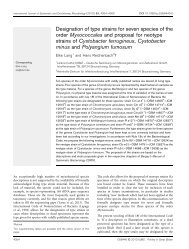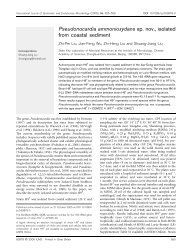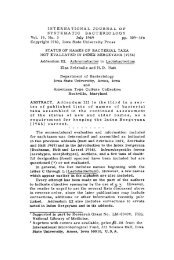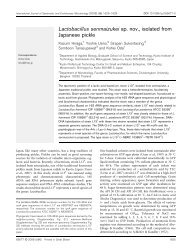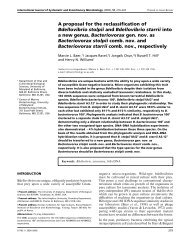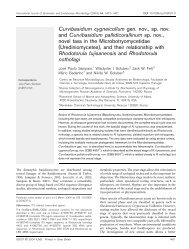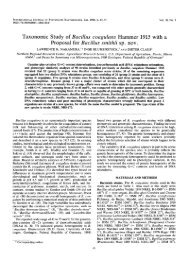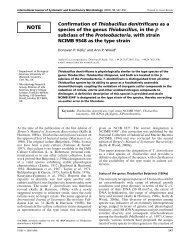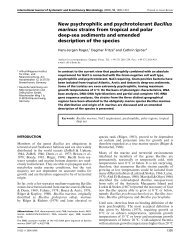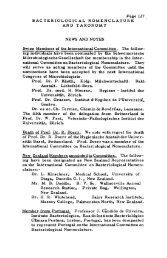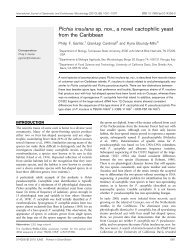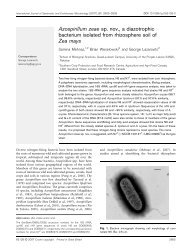Stenotrophomonas acidaminiphila sp. nov., a strictly aerobic ...
Stenotrophomonas acidaminiphila sp. nov., a strictly aerobic ...
Stenotrophomonas acidaminiphila sp. nov., a strictly aerobic ...
Create successful ePaper yourself
Turn your PDF publications into a flip-book with our unique Google optimized e-Paper software.
Table 1. Substrate utilization by strain AMX 19 T<br />
.................................................................................................................................................<br />
Utilization is scored as: , utilized; *, utilized with slight<br />
increase in OD; (), slow and poor use without increase in<br />
OD; (v), variable; , not utilized.<br />
Compound Utilization<br />
Amino acids and related compounds<br />
dl-Alanine <br />
l-Arginine <br />
l-A<strong>sp</strong>aragine <br />
dl-A<strong>sp</strong>artate <br />
l-Cysteine <br />
l-Glutamate <br />
l-Glutamine <br />
dl-Histidine <br />
l-Isoleucine <br />
dl-Leucine <br />
l-Phenylalanine <br />
l-Proline <br />
l-Serine <br />
dl-Threonine <br />
dl-Tyrosine <br />
dl-Valine <br />
Glycine <br />
l-Lysine <br />
l-Methionine <br />
d-Ornithine <br />
dl-Tryptophan <br />
Casamino acids <br />
Peptone from casein <br />
Sugars and related compounds<br />
N-Acetylglucosamine <br />
Maltose <br />
d-Mannose <br />
d-Cellobiose <br />
Amygdalin <br />
d-Arabinose <br />
l-Arabinose <br />
Arbutin <br />
d-Fructose <br />
d-Fucose <br />
l-Fucose <br />
d-Galactose <br />
β-Gentiobiose <br />
d-Glucose <br />
Methyl β-d-glucoside <br />
Glycogen <br />
Inulin <br />
Lactose <br />
d-Lyxose <br />
Methyl α-d-mannoside <br />
Melezitose <br />
Melibiose <br />
d-Raffinose <br />
Rhamnose <br />
Ribose <br />
Salicin <br />
l-Sorbose <br />
Table 1 (cont.)<br />
<strong>Stenotrophomonas</strong> <strong>acidaminiphila</strong> <strong>sp</strong>. <strong>nov</strong>.<br />
Compound Utilization<br />
Starch <br />
Sucrose <br />
d-Tagatose <br />
Trehalose <br />
d-Turanose <br />
d-Xylose <br />
l-Xylose <br />
Methyl β-xyloside <br />
Organic acids<br />
Acetate <br />
Crotonate *<br />
Fumarate <br />
dl-Lactate <br />
Pyruvate <br />
Succinate (v)<br />
Adipate <br />
Butyrate <br />
Caprate <br />
Citrate <br />
Gluconate <br />
2-Ketogluconate <br />
5-Ketogluconate <br />
Malate <br />
Propionate <br />
Alcohols<br />
Adonitol <br />
d-Arabitol <br />
l-Arabitol <br />
Dulcitol <br />
Erythritol <br />
Ethanol <br />
Ethylene glycol <br />
Inositol <br />
Glycerol <br />
d-Mannitol <br />
Propan-1-ol <br />
Sorbitol <br />
Xylitol <br />
Aromatic compounds<br />
Benzoate (v)<br />
4-Carboxybenzaldehyde <br />
o-Phthalate <br />
Phenylacetate <br />
p-Methylbenzoate <br />
Terephthalate <br />
Trimellitate <br />
(CIP 104854T) and S. maltophilia (60.77T) found<br />
during this study was 659%, significantly different<br />
from the value of 35% reported by Drancourt et al.<br />
(1997), which led them to propose S. africana as a<br />
<strong>nov</strong>el <strong>sp</strong>ecies. This difference is probably due to the<br />
fact that the S1 nuclease (TCA) hybridization technique<br />
employed by these authors is known to produce<br />
http://ijs.sgmjournals.org 563



